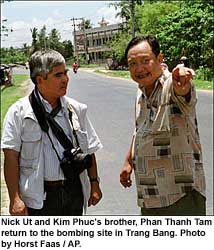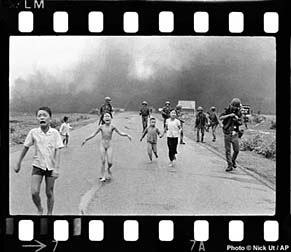|
Epilogue: Trang Bang
Revisited, April 2000
Excerpts from an AP story, April
26, 2000
by Richard Pyle, Associated Press
writer
TRANG BANG, Vietnam - A lot has changed
around this fork in the road since the day in 1972 when napalm exploded
next to the Cao Dai temple and Phan Thi Kim Phuc fled, blistered
and screaming, into photographic history.
 The
highway has been widened, the temple is larger and has a fresh coat
of yellow paint. Kim Phuc's brother, Phan Thanh Tam - the one with
his mouth in a crescent of agony in the famed photo that encapsulated
the war's horrors - is now 41 and has a paunch. He runs an open-air
coffee shack on the very spot where a South Vietnamese bomb hit
on June 8, 1972. The
highway has been widened, the temple is larger and has a fresh coat
of yellow paint. Kim Phuc's brother, Phan Thanh Tam - the one with
his mouth in a crescent of agony in the famed photo that encapsulated
the war's horrors - is now 41 and has a paunch. He runs an open-air
coffee shack on the very spot where a South Vietnamese bomb hit
on June 8, 1972.
Tam says he still has nightmares about
the incident.
But he was all smiles Tuesday when
Associated Press photographer Huynh Cong "Nick" Ut returned to the
village of Trang Bang
"The girl was running, with her arms
out. She was crying, Nong qua! Nong qua!' (Too hot! Too hot!). She
had torn off all her clothes," Ut said. "When I saw she was burned,
I dropped my camera beside the road. I knew I had a good picture.
I got her into our van and took her and the family to the Cu Chi
hospital."
The picture, and that act of mercy,
established a bond between Ut and Kim Phuc "I always feel very sad
when I come back here - I feel sad for Kim Phuc, her family and
the other people who got hurt," he said.
Tam's earnings from the small roadside
restaurant are so meager that he recently had to disconnect his
phone, relying on letters to keep in touch with his sister in Canada.
But he continues to draw a kind of pride from the tragedy of 1972.
"Many people come here to hear the
story," Tam said, holding up a Spanish-language magazine spread
of Ut's pictures, and thumbing into his wallet for the business
cards of recent journalist-visitors .
"When I think about the war," he added,
speaking through an interpreter. "I think about Kim Phuc, and about
the picture."
What happened to Nick Ut's original
film?
From eight rolls of 35mm/36 exposure
film on June 8, 1972
to thirty-one preserved negatives
today.
 When
Nick Ut returned to the Saigon bureau of Associated Press in the
afternoon of June 8, 1972 he brought back eight rolls of black and
white Kodak film (400 ASA) from the events around Trang Bang on
that day, more than 240 exposures. When
Nick Ut returned to the Saigon bureau of Associated Press in the
afternoon of June 8, 1972 he brought back eight rolls of black and
white Kodak film (400 ASA) from the events around Trang Bang on
that day, more than 240 exposures.
Most of the original film has disappeared.
Some was discarded already in Saigon
or returned to Nick Ut. In line with AP's policy at the time all
possibly useful negatives were forwarded to New York headquarters:
This included material selected in the first and second editing
process in Saigon and most of the negatives not used. In New York
the photo desk passed the material to the Photo Library - to be
eventually discarded there, most likely in a big clean-out after
the end of the Vietnam war. Negatives of pictures that were used
for the wires were archived.
Today twelve negatives of the "Kim
Phuc incident" remain with AP. They are locked in a safe and rarely
touched. The Pulitzer winning negative (1973 award) shows a major
scratch across the sky in the upper part of the negative. The original
image has been digitally reconstructed and full-size and cropped
print versions of the picture are now produced from this digital
information.
The pictures used and transmitted
from the original film in June 1972 are preserved in the AP's digital
archive.
After the war Huynh Cong 'Nick' Ut
began a search for the remaining material. Working temporarily in
the Tokyo AP office from 1975 - 1977 he found a small selection
of prints and nineteen original negatives - material that somehow
ended up in Tokyo. He now has both in his private collection.
The negatives and prints show some
of the military operations on the same day, before the "Kim Phuc
incident" and add important information to the basic material in
the AP Photo Library.
|